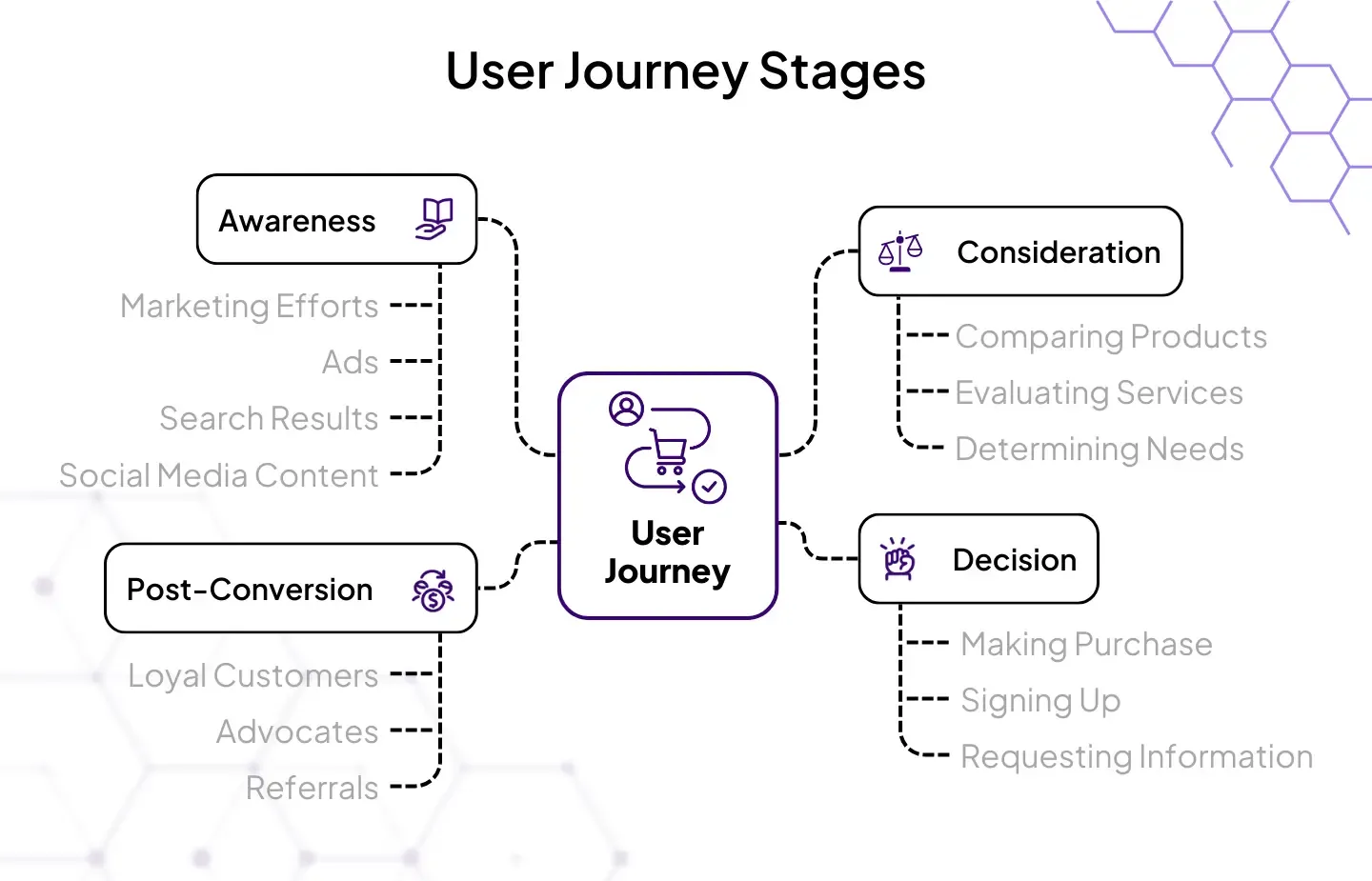In today’s digital world, nailing the user journey is a must for brands aiming to boost conversions and keep customers coming back. The user journey is the path that users take from their first encounter with a brand or product to conversion and beyond. It's rarely straightforward and can look different for every user, depending on the touchpoints and interactions along the way. In this article, we’ll dive into the main stages of the user journey, the challenges brands face in tracking it, and tips for optimizing each step to drive those conversions up.
The User Journey: Stages and Key Touchpoints
The user journey is composed of several stages, each representing different levels of engagement with a brand or product:
- Awareness – When users first learn about your brand, typically through marketing efforts like ads, search results, or social media content.
- Consideration – Users evaluate their options, compare products or services, and determine if your brand meets their needs.
- Decision – Users are ready to take action, such as making a purchase, signing up, or requesting more information.
- Post-Conversion – After the initial conversion, users may continue to engage with the brand, becoming loyal customers or advocates who refer others.

Throughout these stages, users engage with various touchpoints, including:
- Websites
- Mobile apps
- Social media
- Email marketing
- Customer support
- Advertising (paid, organic, display, etc.)
Each of these touchpoints represents an opportunity to engage with the user and guide them through the journey. However, with so many interactions taking place across multiple platforms, tracking and optimizing user behavior at each stage can be a challenge.
Key Challenges in the Customer Conversion Journey
Guiding users smoothly through their journey is no simple task, and several challenges often get in the way:
- Data Fragmentation: With users interacting across multiple platforms, it’s difficult to maintain a cohesive view of the customer journey, which limits insight into their behavior and needs.
- User Drop-Offs: At critical points like checkouts or sign-ups, even small issues can cause users to abandon the process, turning potential conversions into missed opportunities.
- Lack of Personalization: Users today expect tailored experiences; without personalization, the journey can feel generic, reducing engagement and interest.
Getting past these challenges is key to building a smooth, engaging experience that boosts conversions and keeps customers coming back. By syncing up data, reducing drop-offs, making every interaction feel personal, brands can create real, lasting connections with their users.

Strategies for Optimizing the User Journey
Integrate Data Across Touchpoints for a Holistic View
Data fragmentation can be tackled by integrating various data sources into a single view of the customer journey. By linking your CRM, website analytics, and other platforms, you can ensure that you’re collecting and analyzing a comprehensive set of user interactions. This unified approach allows you to better attribute actions to conversions, providing a clearer picture of what’s working and what isn’t. Invest in tools that enable data integration across platforms. Use unified dashboards to monitor the entire customer journey and get real-time insights that can help you identify patterns and opportunities for engagement.
Identify and Address Drop-Offs
The first step in optimizing the user experience is mapping out the common paths users take and identifying key touchpoints and potential obstacles where drop-offs occur. Tools like heatmaps and session recordings can provide insights into friction points, such as complicated checkouts or slow-loading pages, helping you address issues and streamline the journey. Refining these critical stages and responding in real-time, with interventions like live chat, personalized offers, or reminders, keeps users engaged and reduces abandonment, ultimately improving conversion rates.
Personalizing the Experience for Each User
Personalization is key to improving user experience and driving conversions. By leveraging data to understand user preferences and behavior, businesses can tailor the experience to each individual, providing relevant offers, content, and recommendations at the right time. Personalized experiences make users feel valued and increase the likelihood of conversion. Traditional methods of personalization can be time-consuming and hard to scale. Tools such as rule engine automate personalized experiences based on behavior, meaning businesses can easily scale their efforts.
Wrap-Up
Optimizing the user journey isn’t a “one-and-done” deal - it is an ongoing process that requires regular analysis, testing, and leveling-up. By tackling pain points, simplifying the conversion process, and customizing the experience to fit what users actually want, you create a journey that feels smooth, intuitive and enjoyable. Using tools like analytics, heatmaps, and session recordings gives you the insights to keep improving. These moves don’t just drive conversions—they build stronger connections that keep users to stay loyal and come back for more.

Jana Sprušilová
Consultant Tester
